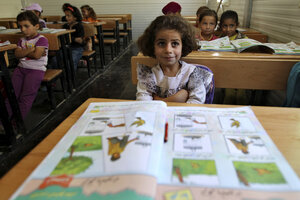Poverty – and giving – are changing
The good news: Millions of people in developing countries have moved out of abject poverty. They'll need a different kind of aid, centering on education. But millions more are trapped at the bottom and need help just to survive.

A Syrian student sits in a UNICEF school at the Al Zaatri refugee camp in the Jordanian city of Mafraq, near the border with Syria.
Muhammad Hamed/Reuters
We have some positive and revelatory news on poverty that can aid our community, helping us become more sensitive in how we give.
Helping is not just about giving money – it's also about training a future workforce within a community. We feel good when we donate, but we also feel good when we have a calling, are productive, and are giving of our talents. We need to afford that opportunity to everyone.
The success in the war against world poverty is very much due to the long-term economic success of developing nations, especially economic growth in Africa, Indonesia and Southeast Asia, and China, as well as strong social programs in South America and investments by both philanthropic and for-profit groups.
There has been extreme growth in the numbers of "middle-class poor." This rising middle class no longer earns $2 per day, but about $12 to $50 per day. For many people, that's 6 to 8 times the amount they used to earn. They can now spend more on their families for better nutrition, health care, and education.
That's the true strength of a community! Healthy bodies and healthy minds bring us into true wealth, not just a donation to help.
It's important to think about this rising class of poor who will need different types of support. It can call for a new philanthropy. For example, education will need to be more advanced in developing nations, not simply relying on year-old donated computers. We need educational technologies, advanced teaching such as blended learning and MOOCs (Massive Open Online Courses) now, as they are current.
In the past, literacy was a goal. Now, our purpose is to become literate in order to get a job, to become equal players in the workforce. Impoverished people know that if they are educated according to the needs in the marketplace, they can get hired. They don't have to move out of their own country or exist with unemployment. They can perform important roles in manufacturing, call centers, data entry, and customer service.
This can provide a tremendous opportunity for our communities. The need is for education to move beyond reading and core competencies into specific knowledge –
to actual skills. That means your giving can set them up to be strong employees in the future for a company, contributing positively to society. If you help the bottom line of the community, you are making it safer, stronger, more loving and kind for everyone.
At the same time, extreme poverty-reduction policies and programs are still needed.
They mostly impact the poorest of the poor. Though their numbers are diminishing, very poor cannot be neglected. We can't always expect them to be able to train for jobs, if they can't eat, don't have a place to sleep, can't think clearly or provide for their families.
So philanthropy's range will continue to exist. We'll still have direct handouts; we'll still need to alleviate poverty by providing opportunities to learn advanced skills. You can focus on one or the other, or both.
As the world changes, it's necessary for us to examine our philanthropic commitments. We may decide to continue investing in education, whether through for-profit investments, donations, volunteering, or policy advocacy.
Yet we should revisit how we serve, our methodology in how we invest, and the results we expect.Below are some interesting, inspiring statistics about the changing and diminishing face of poverty. I know you will join me in celebrating them and ask what you and your community can do to make the "market of poverty" nonexistent in the near future.
The Diminishing Face of Poverty
• In 2010, global poverty was half its 1990 level.
• Half of the long-term rate of decline is attributable to China's growth.
• 660 million people have come out of poverty since 1981.
• East Asia had the highest incidence of poverty in the world in the 1980s: 77 percent of the population lived on $1.25 per day. By 2008, that had dropped to 14 percent.
• Africa has seen the largest recent turnaround in poverty. While the number of people in poverty almost doubled from 205 million in 1981 to 395 million in 2005, by 2008 it fell by 12 million. This is the first time less than half of Africans are below the poverty line.
• The number of poor people has decreased in Latin America and in Eastern Europe and Central Asia since 2000.
• Sources: Pamela Hawley, UniversalGiving; The New York Times; The Economist
• Pamela Hawley is the founder and CEO of UniversalGiving, an award-winning nonprofit helping people to give and volunteer with top-performing, vetted organizations all over the world. She is an Expert Blogger for Fast Company and CSRWire, and leads her own blog Living and Giving.

